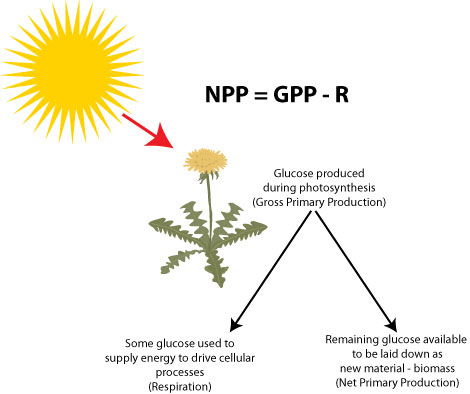<< Hide Menu
Sumi Vora
Sumi Vora
Primary Productivity
The amount of energy in an ecosystem determines how many members of how many species an ecosystem can support. The amount of energy that the producers in an ecosystem capture is called the gross primary productivity (GPP). The GPP is a lot like revenue; in a business, revenue is the total income it receives, without accounting for expenses needed to allow the business to run.
When plants take in sunlight, some of the energy is always lost through respiration. This means that, when an organism converts glucose from the sun into energy, some of it is rendered unusable since it escapes into the atmosphere. As a result, one can find the more accurate amount of available energy, otherwise known as the net primary productivity (NPP), by subtracting the amount of energy respired from the GPP. Since the net primary productivity factors in respiration, it can more accurately demonstrate the energy capacity of any given ecosystem. This can be compared to profit (while revenue is entire, profit takes into consideration the limits and boundaries of what is actually available for expenditure).
Ecosystems are generally very unproductive. 99% of the sunlight that hits the earth is reflected, or it passes through the producers without being absorbed. Only the remaining 1% is captured by photosynthesis and becomes part of the GPP. However, 60% of the GPP is lost to respiration, so only 40% of the GPP, or 0.4% of total solar energy, supports the growth and reproduction of producers.
In short, very little energy is actually available to ecosystems, but after respiration occurs, an ecosystem's productivity levels and species richness levels can be assumed according to their NPP.
Ecosystems with higher levels of productivity are often associated with higher levels of species diversity and the ability to satiate the needs of more consumers on higher and higher trophic levels.

Source: Mr. G's Class

© 2024 Fiveable Inc. All rights reserved.